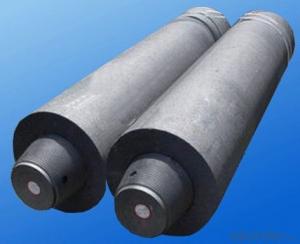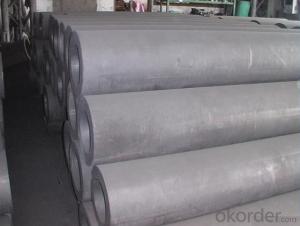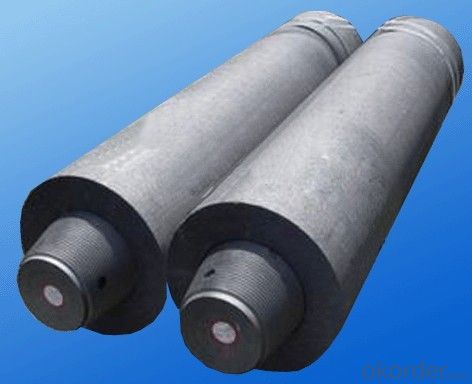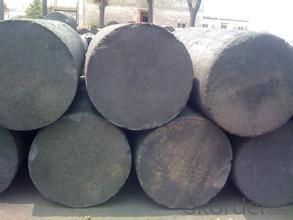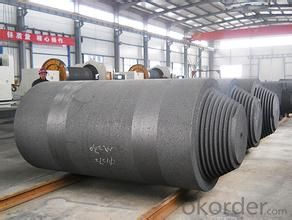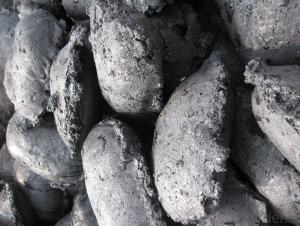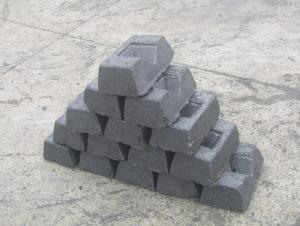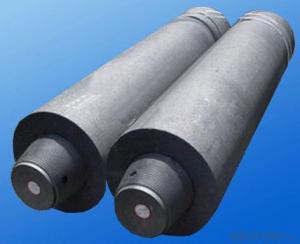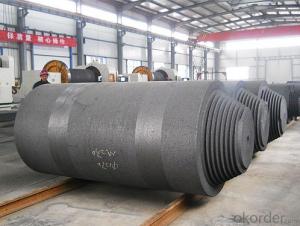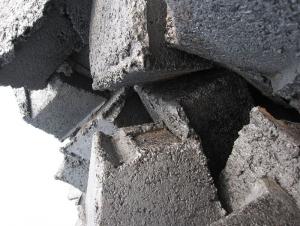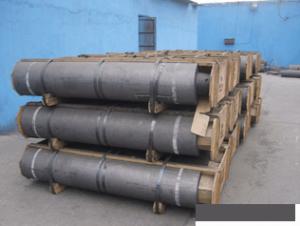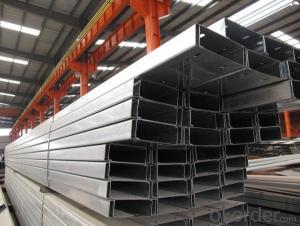Carbon Electrodes with Stable Quality from China
- Loading Port:
- Lianyungang
- Payment Terms:
- TT OR LC
- Min Order Qty:
- 20 m.t.
- Supply Capability:
- 700 m.t./month
OKorder Service Pledge
OKorder Financial Service
You Might Also Like
Carbon Electrodes with Stable Quality from China
Spcifications
1:carbon eletrode
2:for ferroalloy,calcium carbide, silicon metal, manufacture
Graphite/Carbon Electrode Paste Specification:
| PARAMETER UNIT GUARANTEE VALUE | ||||||
| Items | Φ500~Φ700 | Φ750~Φ960 | Φ1020~Φ1400 | |||
| Rs μΩ.m | ≤45 | ≤38 | ≤45 | ≤38 | ≤40 | |
| Bulk Desity g/cm3 | ≥1.55 | ≥1.58 | ≥1.55 | ≥1.58 | ≥1.55 | ≥1.58 |
| Bending Strength MPa | 3.5~7.5 | 4.0~7.5 | 3.5~7.5 | 4.0~7.5 | 3.5~7.5 | 4.0~7.5 |
| Compressive Strength MPa | ≥20.0 | ≥20.0 | ≥20.0 | ≥20.0 | ≥19.0 | ≥19.0 |
| Compressive Strength MPa | 3.2~4.8 | 3.0~4.6 | 3.2~4.8 | 3.0~4.6 | 3.2~4.8 | 3.0~4.6 |
| Ash % | ≤2.5 | ≤2.0 | ≤2.5 | ≤2.0 | ≤2.5 | ≤2.0 |
Picture:
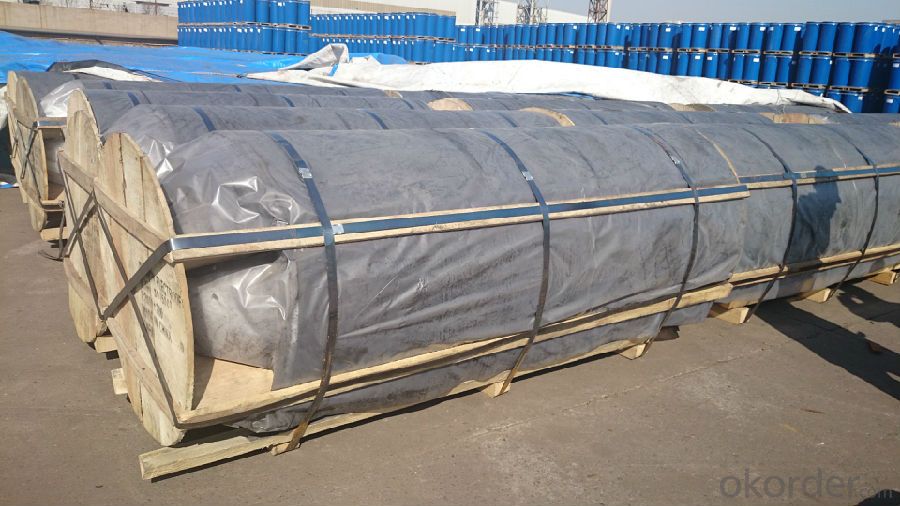
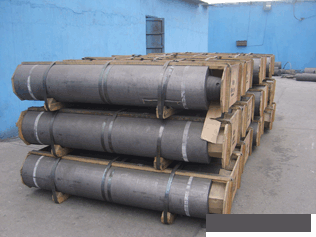
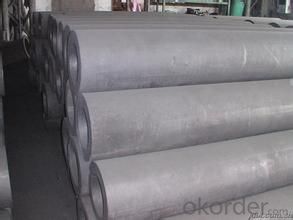
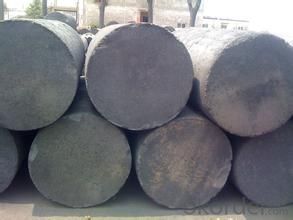
Service:
We can adjust the size based on different enquiry. please contact us if you are interested in this materials, we will send our offer as soon as get your kind email.
Note:
The consumption of Electric Arc Furnace(EAF) is about 3-5kg per ton steel. The Ladle Furnace(LF) is about 1kg per ton steel. The converter with Ladle Furnace(LF) is about 0.5kg per ton steel. All the information is for your reference. There are many factors can influence the consumption, such as the kinds of steel, conduction time, process production and so on. So if you have any question, please don’t hesitate to contact us.
- Q: Process for producing carbon fiber board
- The world produces two types of carbon fibers. One is the PAN based carbon fiber, which is made from polyacrylonitrile and the other is an asphalt based carbon fiber, which is distilled from coal, petroleum and synthetic asphalt into bitumen, and then polymerized into fibers.On the strength of carbon fiber PAN based carbon fiber to Youding asphalt base, so overwhelming absolute in the production of carbon fiber in the world.
- Q: Yes, I have a weapon, want to strengthen 11, said to be advanced furnace rock carbon, do not know how to get, look at the prawns pointing
- Pro, tell you an unfortunate news, out of the eighty furnace rock carbon, old horse recycling, burning their own boilers, and now we strengthen the use of colorless small crystal block, that is, the colorless small crystal block instead of the original furnace rock carbon.
- Q: Does alumina react with carbon?
- NotThe smelting of Al in industry can only be done by electrolysis. Even at high temperatures, the reducibility of C is not as strong as Al, and the melting point of Al2O3 is very high. At this temperature, C has been gasified
- Q: What is the carbon content of 45# steel?
- Between 0.42- and zero point five zero percent per cent
- Q: How does carbon impact soil health?
- Carbon plays a crucial role in maintaining and improving soil health. It is a key component of organic matter, which is essential for fertile and productive soils. When carbon is added to the soil through the decomposition of plant and animal residues, it helps to improve the soil structure, water holding capacity, and nutrient availability. One of the primary ways carbon impacts soil health is through its ability to enhance soil structure. Carbon binds with soil particles to form aggregates, which create pore spaces in the soil. These pore spaces allow for better aeration, water infiltration, and root penetration. Good soil structure promotes the growth of beneficial soil organisms like earthworms and microorganisms, which further contribute to soil health. Carbon also plays a crucial role in improving the water holding capacity of soils. Organic matter, rich in carbon, acts as a sponge by holding moisture and preventing water runoff. This is particularly important in arid or drought-prone regions where water scarcity is a concern. Improved water retention in soils not only helps plants withstand dry periods but also reduces erosion and nutrient leaching. Furthermore, carbon is a vital nutrient for soil microbes. Microorganisms, such as bacteria and fungi, break down organic matter, releasing nutrients that are essential for plant growth. Carbon-rich soils provide a favorable environment for these microorganisms to thrive, leading to increased nutrient availability for plants. Additionally, as microorganisms decompose organic matter, they release beneficial substances like enzymes and hormones that further support plant growth and overall soil health. In conclusion, carbon greatly impacts soil health by improving soil structure, enhancing water holding capacity, and promoting nutrient availability. Therefore, managing and increasing carbon content in soils through practices like adding organic amendments, cover cropping, and reducing tillage can greatly benefit agricultural productivity and sustainability.
- Q: What are the implications of melting permafrost on carbon emissions?
- The melting of permafrost has significant and concerning implications for carbon emissions. Permafrost, which is permanently frozen ground found in cold regions, consists of soil, rocks, and organic matter. It acts as a large carbon sink, storing vast amounts of organic material, such as dead plants and animals, which have been frozen for thousands of years. However, as global temperatures rise, permafrost is thawing at an alarming rate, which could potentially release this stored carbon into the atmosphere. When permafrost thaws, the organic matter contained within it decomposes, releasing greenhouse gases, particularly carbon dioxide (CO2) and methane (CH4), into the atmosphere. Methane is an extremely potent greenhouse gas, with a global warming potential over 25 times greater than that of CO2 over a 100-year period. The release of these gases further contributes to climate change, exacerbating the already accelerating warming trend. The implications of melting permafrost on carbon emissions are twofold. Firstly, the release of large amounts of CO2 and methane from thawing permafrost can significantly amplify the greenhouse effect, leading to more rapid and intense climate change. This can create a feedback loop, where increased warming causes more permafrost thawing, releasing more carbon, and further accelerating global warming. Secondly, the release of carbon from permafrost also affects global carbon budgets and efforts to mitigate climate change. The amount of stored carbon in permafrost is estimated to be twice as much as what is currently present in the Earth's atmosphere. As this carbon is released, it adds to overall carbon emissions, making it more challenging to achieve emission reduction targets outlined in international agreements, such as the Paris Agreement. It also means that efforts to limit global warming to well below 2 degrees Celsius above pre-industrial levels become even more crucial. Moreover, the release of carbon from permafrost also has implications for local ecosystems and communities. Thawing permafrost can lead to the destabilization of infrastructure, including buildings, roads, and pipelines, as well as disrupt traditional livelihoods, such as hunting and reindeer herding. It can also cause land subsidence and increased coastal erosion, posing threats to coastal communities and biodiversity. In conclusion, the implications of melting permafrost on carbon emissions are extensive. It not only exacerbates climate change by releasing potent greenhouse gases into the atmosphere but also hinders global efforts to mitigate carbon emissions. Taking sustainable actions to reduce greenhouse gas emissions and protect permafrost ecosystems are vital to minimize these implications and safeguard the future of our planet.
- Q: How does carbon affect the formation of ground-level ozone?
- Carbon does not directly affect the formation of ground-level ozone. Ground-level ozone is primarily formed through a complex chemical reaction involving oxides of nitrogen (NOx), volatile organic compounds (VOCs), sunlight, and heat. However, carbon-based compounds, such as hydrocarbons, can indirectly impact the formation of ground-level ozone. When carbon-based compounds, like hydrocarbons, are emitted into the atmosphere from sources such as vehicles, industrial processes, and fossil fuel combustion, they can react with nitrogen oxides in the presence of sunlight to form ozone. This reaction occurs in the presence of volatile organic compounds (VOCs) and nitrogen oxides (NOx), which are the primary precursors of ground-level ozone. Elevated levels of carbon-based compounds, particularly in the presence of NOx and sunlight, can enhance the formation of ground-level ozone. This is because the carbon-based compounds act as catalysts, accelerating the chemical reactions that lead to ozone formation. Additionally, the combustion of carbon-based fuels, such as gasoline and diesel, releases nitrogen oxides into the atmosphere, which can further contribute to the formation of ground-level ozone. It is important to note that carbon-based compounds alone do not directly cause ground-level ozone pollution. Rather, they contribute to the formation of ground-level ozone when combined with other pollutants, such as nitrogen oxides and sunlight. To mitigate the formation of ground-level ozone, it is necessary to reduce emissions of carbon-based compounds, as well as other ozone precursors like nitrogen oxides and volatile organic compounds.
- Q: How can carbon be stored underground?
- Carbon capture and storage (CCS) is a process that allows for the underground storage of carbon. This process involves the capture of carbon dioxide (CO2) emissions from industrial sources, such as power plants or cement factories, followed by the storage of the captured CO2 deep underground in geological formations. To begin, the CO2 emissions are captured before they are released into the atmosphere. Various technologies, such as post-combustion capture, pre-combustion capture, and oxy-fuel combustion, are available for this purpose. These technologies separate the CO2 from other gases, like nitrogen, resulting in a concentrated stream of CO2 that is easy to store. Once the CO2 is captured, it must be transported to a suitable storage site. Depending on the distance and location of the storage site, transportation can be done through pipelines or ships. The CO2 is then injected deep underground into geological formations, including depleted oil and gas reservoirs, saline aquifers, or coal seams. The selection of storage sites is done carefully, taking into consideration their ability to safely and permanently store the CO2. The chosen geological formations must have an impermeable rock layer, known as a caprock, to prevent CO2 leakage to the surface. Regular monitoring of the storage sites ensures that the stored CO2 remains securely underground. The storage of carbon underground has significant benefits in reducing CO2 emissions and addressing climate change. It effectively prevents the release of CO2 into the atmosphere, where it contributes to the greenhouse effect and global warming. Additionally, CCS can be combined with enhanced oil recovery (EOR) techniques, using the injected CO2 to extract more oil from depleted reservoirs, making the process economically viable. However, it is important to note that carbon storage is not a permanent solution to climate change. While it can help in reducing emissions during the transition to cleaner energy sources, it should not replace efforts to decarbonize the economy and reduce dependence on fossil fuels. Moreover, the long-term safety and environmental impacts of underground carbon storage need thorough examination to ensure its effectiveness and sustainability.
- Q: What are the main sources of carbon emissions?
- Human activities, particularly the burning of fossil fuels like coal, oil, and natural gas, are primarily attributed as the main sources of carbon emissions. When these fossil fuels are combusted for electricity generation, transportation, and industrial processes, significant amounts of carbon dioxide (CO2) are released into the atmosphere. Deforestation and land-use changes also play a major role in carbon emissions. Clearing or burning forests leads to the release of carbon stored in trees and vegetation as CO2, contributing to greenhouse gas emissions. Moreover, the decrease in forests reduces their ability to absorb carbon dioxide through photosynthesis, worsening the issue. Substantial carbon emissions are also generated by industrial processes such as cement production and chemical manufacturing. Cement production, in particular, produces a significant amount of CO2 due to the chemical reactions involved. Agriculture is another significant source of carbon emissions, primarily through the release of methane (CH4) and nitrous oxide (N2O). Livestock farming, especially cattle, produces methane through enteric fermentation and manure management. Nitrous oxide is released from the use of synthetic fertilizers and manure in agricultural practices. Lastly, waste management and disposal contribute to carbon emissions. Landfills, where organic waste decomposes, release methane gas. Additionally, the incineration of waste also releases CO2 and other greenhouse gases into the atmosphere. To reduce carbon emissions, it is vital to address these primary sources. This can be achieved through transitioning to cleaner energy sources, promoting sustainable land-use practices, improving industrial processes, adopting more sustainable agricultural practices, and implementing effective waste management strategies.
- Q: How are carbon nanotubes produced?
- Carbon nanotubes are produced through a process called chemical vapor deposition (CVD), which involves the use of a carbon-containing gas and a catalyst. In this process, a substrate is coated with a catalyst material, usually iron, nickel, or cobalt. The substrate is then placed in a high-temperature furnace, typically around 800-1000 degrees Celsius, and exposed to a carbon-containing gas, such as methane or ethylene. As the gas decomposes at high temperatures, carbon atoms are released and deposited onto the catalyst nanoparticles on the substrate. These carbon atoms then arrange themselves in a hexagonal pattern, forming a tube-like structure, which grows vertically from the catalyst particles. The growth of the nanotubes is driven by the difference in carbon solubility between the catalyst and the growing tube. The diameter, length, and alignment of the carbon nanotubes can be controlled by adjusting various parameters such as the temperature, gas flow rate, and catalyst material. By manipulating these parameters, researchers can produce carbon nanotubes with specific characteristics suitable for various applications. It's worth noting that there are other methods to produce carbon nanotubes, such as arc discharge and laser ablation, but CVD is the most commonly used method due to its scalability and ability to produce large quantities of nanotubes. Additionally, CVD allows for the growth of vertically aligned nanotube arrays, which are highly desirable for many applications.
Send your message to us
Carbon Electrodes with Stable Quality from China
- Loading Port:
- Lianyungang
- Payment Terms:
- TT OR LC
- Min Order Qty:
- 20 m.t.
- Supply Capability:
- 700 m.t./month
OKorder Service Pledge
OKorder Financial Service
Similar products
Hot products
Hot Searches
Related keywords
